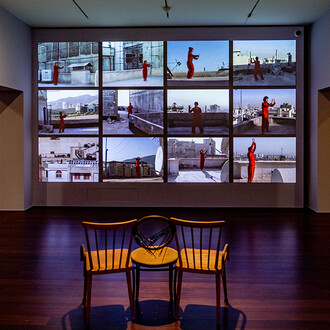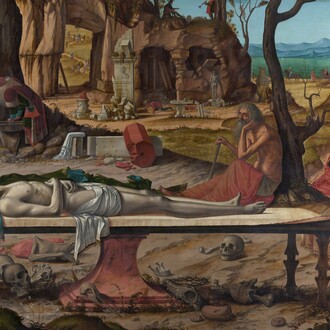What difference is there between the domestic environment and the artistic context? Don’t both involve displaying something? And aren’t the objects that are presented laden with meaning in both cases? (...) We are all collectors. It is a part of our nature.
(Haim Steinbach).
…before introducing the display of structure and objects, it's important to study the given site; the floor, the walls, the door etc. The work of "setting in motion”the environment by carrying out operations of the architecture…Steinbach takes on this dimension and seeks a correspondence that enhances the fluidity between object and context.
(Germano Celant).
In his solo show at the Lia Rumma Gallery Haim Steinbach employs standard architectural building materials - metal studs, drywall, prefabricated shelving units, paint and wallpaper – evoking both domestic and institutional spaces as places ready for presentation. The artist exhibits over 50 objects selected from seven collections. The objects are arranged and placed on shelves, and are displayed on both the permanent gallery walls and Steinbach’s temporary walls.
The concept for the exhibition began with a proposition to the collectors to choose, with mutual agreement, approximately a dozen objects belonging to them. Steinbach subsequently made a selection by reducing the collection to a few objects, at times punctuated by the inclusion of an object from his own collection.
Walls, banisters, fences and furniture articulate categories of spaces and define boundaries for activities and rituals. Inadvertently they also stage real life in a way that underscores its theatricality. The “props” employed by Steinbach re-enact that fine line between the every day and its surroundings. The introduction of the collected objects sets in motion the social dynamic of “the relation between ‘the subjective’, search for meaning and ‘objective things.’”
On the ground floor a group of objects from Lia Rumma’s collection mark the long relationship of friendship and collaboration between the dealer and artist. The glass and ceramic vases, plates, bowls, cups, wine decanters and sculptures are lined up on an extended prefabricated shelving unit that bisect the space. These personal belongings are contrasted by an elongated shelf, built into the adjacent wall framing, which supports a series of objects from an extensive collection of African tribal currency. On the opening night 6 musicians will employ another typology of objects, wind instruments. They will perform a range of sounds and musical sequences.
Over the years Haim Steinbach has put into use a shelf of his own invention that he refers to a as a device. It is a device that divides in that it is made of proportionally equal units of different sizes. These are calibrated in relation to the objects they support, and that are contingent on each other. On the first floor three such works are distributed on the gallery walls with each one holding a group of objects from a specific collection. A skeletal wall traversing the space includes a shelf with a selection of small unselected ceramic objects from the three collections.
A collection of pipes and punches is presented on a bare studded wall built in the middle of the second floor space. These are displayed in relation to a work hung on the gallery wall and holding a selected group of the African tribal currency. A work, “Untitled (plant, artichoke)” 2013, with objects chosen by Haim Steinbach from his own collection is also introduced here. In doing so, Steinbach exposes the contingency of objects to their context. While architecture shapes space, in this third room, the shape of things shapes space. While we experience space in volume and in relation to scale, it is the language of shape, pattern and surface that is the grounding reality, the cultural matrix of connectedness.
Haim Steinbach was born in Rehovot (Israel) in 1944 and in 1957 moved with his family to New York. He received a BFA from Pratt Institute in 1968 and a Master’s degree from Yale University in 1973. His first museum show was in 1988 at the CAPC Musée d’Art Contemporain in Bordeaux. For Documenta 9 (1992), Steinbach borrowed and displayed several objects belonging to the director Jan Hoet,. His works have been exhibited on various occasions at the Venice Biennale (1993, 1997, and 2001). Important exhibitions of his work have been organized by the Solomon Guggenheim Museum (with Ettore Spalletti, in 1993), the Castello di Rivoli (in 1995 and 2004), the Museum Moderner Kunst Stiftung Ludwig in Vienna (1997–98), the Neuer Berliner Kunstverein (2000), the Berkeley Art Museum and the Pacific Film Archive (2005). In 2012 the Artist's Institute in New York devoted a series of exhibitions over a 6-month period to the artists’s work, and it also asked the artist to curate an exhibition entitled The Bigger Picture. He has taught at various institutions including The School of Visual Arts in New York, and the University of California in San Diego.
Galleria Lia Rumma
Via Stilicone, 19
Milan 20154 Italy
Ph. +39 02 29000101
Fax +39 02 36511702
info@liarumma.it
www.liarumma.it
Opening hours
From Tuesday to Saturday
11.00am - 1.30pm and 2.30pm - 7.00pm














